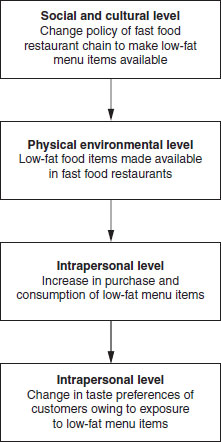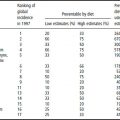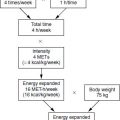5.1 Introduction
The actions that people take are determined by a wide range of factors. Individual beliefs, friends and family, laws and regulations, and the physical environment are all factors that help to determine how people live their lives. The ecological approach was developed by social scientists to help to understand this complex web of influences on behavior. This approach has been adapted by researchers and practitioners in health promotion to help to understand and influence health behaviors. This chapter will describe the ecological approach and its use in understanding nutrition behavior. In addition, the chapter will explain how this approach can be used to develop effective interventions to change people’s eating patterns.
5.2 Definition of the ecological approach
It is helpful to begin our exploration of the ecological approach by defining some of its key elements. Green and colleagues stated “The ecological model of health promotion presents health as a product of the interdependence between the individual and subsystems of the ecosystem (e.g., family, community, culture, physical and social environment)” That is, health is not determined solely by an individual and his or her personal actions and characteristics. Rather, health is determined by:
- individual actions and characteristics
- factors outside the individual
- an interaction between the two.
For example, the incidence of overweight and obesity has been increasing around the world and has reached epidemic proportions, according to many health authorities. Overweight and obesity result from positive energy imbalance. That is, when people burn too few calories through physical activity, relative to their intake of calories from eating, they gain weight. Eating and physical activity patterns are individual characteristics. Individuals decide how much physical activity to take and which foods to consume. However, according to the ecological approach, these personal decisions about exercise and eating patterns are only part of the story. The amount and type of food a person eats, and the amount of physical activity they take are also determined by factors outside the individual. These environmental factors include the availability of different types of foods and the demands for physical activity placed on a person by their social and physical environment. According to many researchers, the current epidemic of obesity may be due to longterm changes in the availability of energy-dense foods, to societal changes that support consumption of these foods, to reduced demands for physical activity, and to reduced opportunities and support for physical activity in our societies. There is evidence, for example, that the portion size of foods people consume outside the home has been increasing for many years. As a result, the number of calories consumed by people may have increased. Thus, portion size is a factor in the ecosystem that exists outside the individual, which can influence the number of calories a person consumes and which can have an influence on weight and health status.
In the ecological approach, health behavior is also believed to be determined by multiple levels of influence, including intrapersonal factors and environmental factors. For example, a preference for low-fat foods (intrapersonal factor) will partially determine whether a person eats low-fat snacks. However, the availability (environmental factor) of low-fat snacks in the home, restaurants and cafeteria where a person works also determine whether that person will eat low-fat snacks. A person’s friends and colleagues also influence how he or she eats through social pressure, social norms and modeling (environmental–interpersonal factor). Thus, a person’s ability to eat low-fat snacks may be limited or facilitated by their physical and social environments.
Defining characteristics of the ecological approach are summarized in Box 5.1.
- Behavior is determined by multiple levels of influence, including intrapersonal factors and environmental factors.
- Health is a product of the interdependence between the individual and subsystems of the ecosystem (e.g. family, community, culture, physical and social environment).
5.3 Individual versus ecological approaches
It is important to understand the distinction between individual-level approaches and ecological approaches to explaining nutrition behavior. Individual-level approaches focus solely on factors within the individual, or on the individual’s perceptions of their environment to explain nutrition behavior. Factors within the individual such as knowledge, positive or negative attitudes, and personal beliefs about social norms are used in the individual approach to explain nutrition behavior. For example, if an individual holds positive attitudes towards low-fat eating, they are more likely to limit consumption of high-fat snacks, to prepare foods with less fat and to select lower fat meals when eating out in restaurants or cafeterias. The ecological approach recognizes the importance of individual factors in determining nutrition behavior, but is also concerned with factors outside the individual (i.e. environmental factors), and with the interaction between the individual and the environment. The interaction between individual influences and environmental influences, in particular, is what sets the ecological approach apart from the individual approach. The interaction means that various individuals may be influenced by different environmental factors or in different ways by the same environmental factors. For example, a person at a high income level may not be influenced by fluctuations in the price of produce and may purchase the same amount of fruit and vegetables regardless of these fluctuations. However, lower income individuals may be readily influenced by price fluctuations and may be less likely to purchase and consume fruit and vegetables when prices are high.
Individual versus environmental factors in the ecological approach are summarized in Box 5.2.
The use of the ecological approach does not minimize the importance of changes in knowledge and psychosocial factors within the individual. Rather, this approach seeks to identify additional levels of influence on behavior, and incorporate these to help in the understanding of human behavior. The nutrition educator can take advantage of these additional levels of influence to produce stronger changes in nutrition behavior by intervening directly on environmental factors. Interventions designed using the ecological approach move beyond individual one-on-one encounters with a nutrition educator, and can occur in a number of settings including schools, churches, grocery stores and state legislatures, to name just a few.
- Individual causes of nutrition behavior are recognized in the ecological approach.
- Environmental causes of nutrition behavior are also seen as important.
- The interaction between individual and environmental causes of behavior is important in the ecological model.
5.4 Key principles in the ecological approach
Various models have been proposed to describe the ecological approach. These models share several common elements that are described below.
Levels of organization in the ecological approach
The ecosystem is very complex. Models of the ecological approach attempt to characterize the ecosystem by dividing it into various levels. This chapter uses one of the simpler formulations that includes three main levels of the ecosystem. These include the intrapersonal, social and cultural, and physical levels. The ecological approach suggests that each of these levels is important in determining behavior. Thus, it is important to understand each level as a means of understanding nutrition behavior and designing interventions to change that behavior.
Intrapersonal level
These are attitudes, beliefs and perceptions that individuals hold towards dietary behavior. Many of these variables have been examined in research projects and are related to nutrition behavior. These attitudes, beliefs and perceptions exist within the individual and may or may not be shared with other people. For example, perceived self-efficacy is an individual’s belief in their ability to change a specific behavior such as increasing fruit and vegetable consumption or reducing fat consumption. Higher self-efficacy leads to greater change in behavior. If a woman believes that she is able to prepare more vegetarian meals, she is more likely to do so than a woman who does not believe that she is capable of preparing these meals. Another example of an intrapersonal factor is perceived barriers to changing one’s diet. People differ in their perceptions of the barriers encountered in changing their nutrition behavior. Some people perceive a high number of barriers, while others perceive a low number of barriers. If perceptions of barriers are high, this may inhibit a person from changing the way they eat. For example, a man may believe that fruit and vegetables are expensive, that they spoil quickly and that they will make his meals less enjoyable. These could be seen as perceived barriers to eating more fruit and vegetables. If he believes that a large number of barriers exist, he is less likely to purchase fruit and vegetables. Numerous theories exist to describe the effects that these intrapersonal factors have on nutrition behavior, including social cognitive theory, the Health Belief Model and the Theory of Planned Behavior. In addition, these factors have often been used to design nutrition education programs.
- Perceived barriers to dietary change
- Perceived benefits of dietary change
- Perceived social norms for eating different foods
- Perceived self-efficacy for dietary change
- Knowledge related to nutrition
- Intention to eat specific foods
- Taste preferences
- Skills for food preparation.
Examples of factors included in the intrapersonal level of the environment are listed in Box 5.3.
Social and cultural environments
This level of the ecological approach includes the interactions that people have with family, friends, institutions (e.g. churches, schools, worksites) and government policies or laws. Broad cultural influences are also often considered a part of the social and cultural environment.
In the ecological approach, these different factors (e.g. family, worksite, government) can influence one another. Thus, a complete understanding of nutrition behavior requires an analysis of the diverse relationships between these factors, and their ultimate linkage to the behavior of individuals. For example, changes in national dietary guidelines by the federal government are typically covered by the media, which in turn produces increases in awareness by individuals. These individuals may then make different food purchasing decisions that affect the price and availability of food items in stores. Thus, the modification of a dietary guideline can trigger changes in individuals, and in the social and cultural, and physical environmental levels of the ecosystem.
A plausible target for intervention using an ecological approach is to change organizations, rather than individuals within organizations. For example, a nutrition intervention based on the ecological approach may change the types of foods offered in a worksite cafeteria. The elimination of high-fat foods and high-fat preparation methods from the cafeteria is a legitimate target of an ecological intervention. These changes in offerings may lead directly to reduced fat consumption among the employees of the worksite. This intervention does not aim to change intrapersonal factors, but can produce a change in eating patterns by intervening directly in the social and cultural environment. The intervention may also reduce fat consumption indirectly by exposing workers to new low-fat food options and changing their preference for these foods. This modification in taste preferences may then carry over into other environments, influencing the foods consumed at home and in restaurants.
A large number of avenues for nutrition intervention can be identified within the social and cultural level of the environment. Examples are a mass media campaign mounted to alter the cultural norms for healthy eating, and a church-based intervention in which members support one another in preparing low-fat, high-fiber foods for church events, and where the pastor models and supports healthy eating.
Physical environment
The presence of different types of food, and other characteristics of the physical infrastructure that help to determine what we eat, define this level of the ecosystem. The most obvious example of the physical environment is the availability of different types of food. Foods that are more available are more likely to be consumed. Conversely, foods that are not available will not be consumed. Thus, efforts to make more fruit and vegetables present in restaurants, cafeterias and homes may well lead to increases in consumption. Similarly, the removal of high-fat and high-salt food items from vending machines in schools, worksites or other locations may lead to reduced consumption of these food items. The physical environment may also extend beyond the simple availability of certain food items. For example, if a family does not have a refrigerator, some food items may not be kept at home because of problems with spoilage. Such a family may be forced to consume large quantities of canned foods or fast foods, which may be higher in sugar, fat and salt than alternatives that must be kept refrigerated. As noted earlier in this chapter, portion size is an environmental factor that has received increasing attention among nutrition researchers and which may contribute to increased energy intake and the epidemic of obesity being experienced in many countries around the world. The increasing tendency for families to eat meals that are prepared outside the home, and the typically higher energy density and fat content of these foods, can greatly impact the quality of the diet. The labeling of food items is another form of physical environmental change that can impact dietary habits. The presence of food labels that are easy to understand, and that provide appropriate information for people to make decisions about the foods they purchase and eat, could impact eating habits.
Finally, the seasonal availability of foods, and the impact that this availability could have on prices, is another example of an environmental factor that may influence eating habits. If foods are less available in the winter, or prices are higher owing to lower supply and higher import costs, people are less likely to purchase these foods. The influence of seasonal factors may have been diminished in recent years in many countries because of the greater availability of low-cost imported fruits and vegetables.
Levels of organization in the ecological approach are shown in Box 5.4.
- Intrapersonal: including knowledge, attitudes and beliefs.
- Social and cultural: including friends and coworkers, settings such as schools and churches, organizations such as local governments, and laws and policy.
- Physical environment: including climate, geography, and availability of foods in the home and neighborhoods.
5.5 Intervention
Targets of intervention
When an intervention is developed using the ecological approach, it is important to define the level of the organization that will be targeted by that intervention. Some interventions will target factors at the intrapersonal level, some will target the social and cultural level, and others will attempt to influence the physical environment. Although each of these interventions is attempting to improve the diet of individuals, their influence may be produced through change in social and cultural or physical levels of the environment. Targets of the intervention are usually considered more important than the settings in which the interventions occur. Targets receive intervention in the hope of making changes that will ultimately benefit the individual clients.
Settings for intervention
The setting is a particular organization, community or society through which clients for an intervention are identified. The setting for an intervention and the targets of the intervention are not the same thing. Individuals may be selected as a target for an intervention, with those individuals being reached through churches, which provide the setting for the intervention. Alternatively, one may be interested in changing the policies of the churches themselves, making churches the target of the intervention, and the setting is both the church and the community from which the church is drawn.
Intervention strategy
To develop an intervention based on the ecological approach, it is important to define an intervention strategy that describes how the intervention targets interact within a given setting to produce change in individuals. An intervention may be designed first to produce changes in an organization, which then lead to changes in the individual clients. For example, nutrition educators may work directly with fast food restaurants to offer a low-fat alternative to their usual high-fat meals. This is a change in the policy of the fast food organization (social and cultural level), which will lead to increased availability of low-fat menu items (physical environmental level), increased consumption of low-fat foods by customers (intrapersonal level) and perhaps a change in the customers’ preferences for low-fat foods (intrapersonal level) (Figure 5.1). Another example can be drawn from the 5-a-Day for Better Health program conducted in the USA. In this program, the National Cancer Institute, a federal government agency, collaborated with wholesaler producers of fruit and vegetables to increase the consumption of fruit and vegetables in ways consistent with national guidelines. This collaboration led to the use of several major intervention activities at the social and cultural level of the environment. These activities included a national media campaign, the licensing of fruit and vegetables retailers to promote fruit and vegetables in their stores, the formation of state coalitions to promote fruit and vegetables in their states, and the completion of carefully evaluated community intervention studies. The combination of these activities at the social and cultural level of the environment led to additional changes in individuals’ knowledge, attitudes and preferences about fruit and vegetables (intrapersonal level), to changes in the availability of fruit and vegetables (physical environmental level), and eventually to changes in the consumption of fruit and vegetables by individuals (intrapersonal level).
Figure 5.1 Strategy for a fast food intervention using the ecological approach.

The examples above illustrate the importance of defining the strategy to be used for the intervention when an ecological approach is used. Since three levels and many factors within each level can be used to mount an intervention, a planning process is crucial to maximize the efficiency and the effectiveness of the intervention.
5.6 Advantages and disadvantages of this approach
Importance of the ecological approach
Stay updated, free articles. Join our Telegram channel

Full access? Get Clinical Tree








